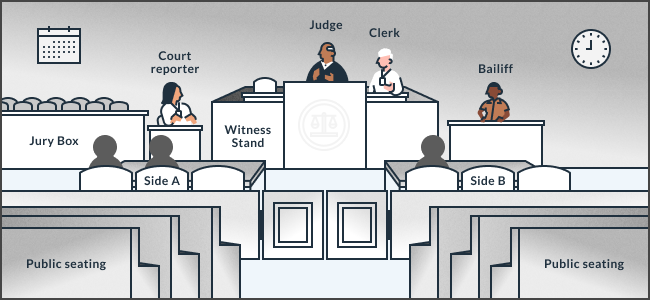4. Criminal trial overview
A basic overview of the main steps in a criminal jury trial.
Criminal trial
Criminal trials are open to the public. Defendants have a right to a jury trial, which means a jury listens to both sides present their case and then decides if the defendant is guilty or not. If the defendant wants, they can ask for a judge to decide instead.
Trials can last from a day to many months. In general, the more witnesses in a case the longer it can last. Trials also tend to be longer if there is more than 1 defendant in the case.

Criminal trial overview
-
Pick a jury and evidence issues
Jury selection
A jury has 12 members of the public. To decide who is on the jury, both sides get to ask potential jurors questions to make sure they can be fair. The judge may ask questions as well. This is called voir dire.
Issues the judge needs to decide before either side presents its case
When the jury is not in the courtroom, either side can ask the judge to decide whether or how certain evidence can be used, if at all. For example, if the defendant has a prior conviction the defense may ask the judge to decide whether the prosecution can bring it up if the defendant testifies.
-
Opening statements
Both sides start by giving an overview of what they plan to show at the trial. This is not an argument, it's where they describe their case and what evidence they'll have.
-
Prosecution presents its case
The prosecution presents its witnesses and evidence. The defense can ask the witnesses questions as well (called cross-examination). The prosecution must prove the defendant committed each crime the person is charged with beyond a reasonable doubt.
-
Defense presents it case
The defense does not have to present a case. If they do, they can have witnesses testify or show evidence that supports their side. The prosecutor can ask the witnesses questions.
If the defendant wants, they can also testify. They do not have to. They have the right to remain silent. The jury cannot use the fact that the defendant chose not to testify against them (assume they are guilty).
If the defense does present a case, the prosecution gets another chance to present witnesses to respond to what the defense witnesses said.
-
Closing arguments
Both sides get a final chance to convince the jury to vote guilty or not guilty. The prosecutor argues that they have proven the defendant is guilty beyond a reasonable doubt and that jury should vote guilty. The defendant can argue why the prosecutor did not prove their case, and even that the defendant is innocent.
-
Jury makes a decision
Jury instructions
Typically, after closing arguments, the judge gives the jury instructions. These are the legal standards the jury uses to decide a case. They include a legal definition of the crime.
Jury deliberations and verdict
The jurors meet in private and discuss the case and vote guilty or not guilty. This is called deliberations. To reach a final decision (a verdict), the jury must all agree that a person is guilty or not guilty of each charge.
- If they vote not guilty, the person is acquitted and can't be tried again. Not guilty does not mean innocent. It means the jury was not convinced beyond reasonable doubt the person was guilty.
- If the jurors all vote guilty, then the judge decides the sentence.
- If jurors cannot agree, the judge can declare a mistrial. This is sometimes called a hung jury. The prosecutor may or may not decide to try the case again.
What's next?
If the jury found the defendant guilty or the defendant pled guilty, the next step is sentencing. This may happen shortly after the trial or a week to months later.

